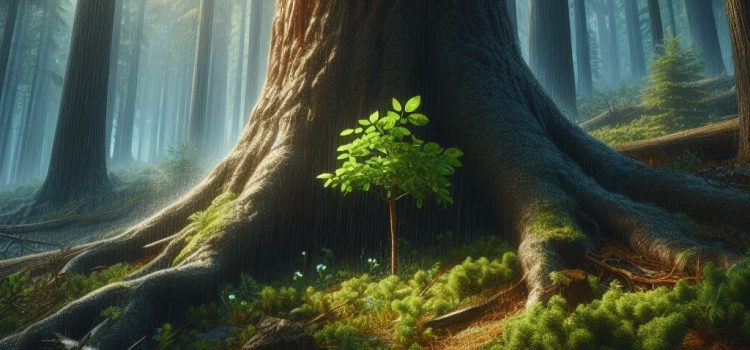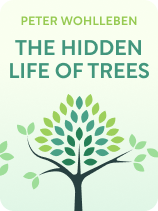

This article is an excerpt from the Shortform book guide to "The Hidden Life of Trees" by Peter Wohlleben. Shortform has the world's best summaries and analyses of books you should be reading.
Like this article? Sign up for a free trial here.
In what ways do trees cooperate with one another and other species? How do trees protect human communities from danger?
Unlike many other forms of life, trees of different species work together to create a communal living space. Thanks to the cooperation of trees, forests are able to maintain a sustainable ecosystem.
Keep reading to understand more about how symbiosis in nature works.
How Trees Cooperate
In his book, Peter Wohlleben explains the symbiosis in nature by showing how trees in old-growth forests cooperate, sharing nutrients with one another and establishing reciprocal relationships with other species.
Trees Cooperate by Sharing Resources
Trees in a forest function as critical support systems for each other, particularly when it comes to weathering severe environmental conditions. Older trees provide shelter for younger ones, creating a canopy that offers protection from harsh weather. Then, when younger trees are more established, older trees die, creating space for smaller trees to grow. Together, they form a communal living space, mitigating the harshness of the weather and creating small local climates that support their survival.
(Shortform note: Trees also play a crucial role in protecting human communities from potentially dangerous environmental events. In mountainous regions, humans have developed structures to mitigate the impact of rock falls, but simulation modeling techniques have revealed how forests play a crucial role in natural protection against rock falls—they serve as barriers that absorb and dissipate energy from falling rocks. Simulation models suggest that coppice forests with younger trees are particularly effective at reducing the impact of falling rocks due to their greater flexibility and ability to absorb energy.)
Additionally, writes Wohlleben, trees in a forest exhibit a remarkable level of cooperation in sharing nutrients. They maintain a uniform rate of photosynthesis, hinting at a shared system of nutrient distribution. Wohlleben attributes this to an intricate underground network of roots and beneficial fungi that work in tandem to extract and distribute essential nutrients, especially sugars, from the soil. This system functions much like the diverse organisms within the soil that decompose organic matter and recycle nutrients, contributing to maintaining a healthy and sustainable ecosystem.
| Do Trees Share Resources Equally? In his discussion of trees’ cooperation, Wohlleben cites the research of Suzanne Simard, Canadian ecologist and author of Finding the Mother Tree. In her research, Simard found that trees didn’t necessarily share resources equally: Within the forest structure, there were often “mother trees,” older trees that acted as central hubs in nutrient distribution. According to Simard, while these mother trees sent nutrients to other trees in the network, they exhibited a preferential behavior toward their own kin. In the event of stress, such as disease, drought, or nutrient deficiency, the “mother trees” increase the quantity of nutrients sent to their own offspring. Near the end of their lives, these mother trees release increasing amounts of nutrients and energy, much like a human passes on resources to their offspring. The system paints a picture of not just a mutualistic exchange of resources but a complex social system where trees take care of their own offspring first, suggesting that nutrient transfer isn’t simply a byproduct of fungi connecting multiple trees. |
Trees Cooperate With Other Species
Wohlleben says that trees don’t just cooperate with other trees but also have reciprocal relationships with other organisms, like fungi. Unlike trees, fungi can’t photosynthesize independently. Instead, they form organic connections with plants, like trees, to receive essential sugars and other carbohydrates. In return, the fungi spread through tree roots, creating an extensive mycelial network that dramatically increases an individual tree’s root surface area, allowing it to absorb more water and nutrients. The mycelial web also interconnects the roots of various trees, promoting nutrient exchange among them. Fungi also act as guardians for their tree partners, filtering out toxins and warding off harmful bacteria or other antagonistic fungi.
(Shortform note: While Wohlleben doesn’t ignore the fact of competition in the natural world, he chooses not to focus on it. In reality, trees behave in ways that don’t always align with Wohlleben’s descriptions, and they sometimes compete for survival. For example, black walnut trees release a natural herbicide that harms other plants, some eucalyptus species shed their bark to fuel fires to eliminate their competition, and certain types of fig trees grow by strangling their host trees.)
None of this cooperation is possible if a tree is isolated, says Wohlleben. These relationships only occur in natural forests. An individual tree can’t build a friendly microclimate, moderate temperature, protect seedlings from a storm or unrelenting sunlight, or share nutrients. Forests that have been planted by humans also fail to replicate this intimate network. As Wohlleben points out, planted trees often have damaged root systems that fail to create the rich root networks characteristic of long-standing forests.
(Shortform note: Forests that have been planted by humans often fail to reproduce the complex underground fungal networks characteristic of old-growth forests for several reasons. First, these forests have limited biodiversity, as they’re often dominated by one or two species, which restricts the range of fungi that can form symbiotic relationships with the trees. Second, the soil in planted forests, unlike the nutrient-rich soil in natural forests honed over time, lacks the microorganisms necessary to promote fungal growth. Finally, human activities, such as premature harvesting and pesticide use, interfere with the natural development of robust fungal networks in these artificial forests.)

———End of Preview———
Like what you just read? Read the rest of the world's best book summary and analysis of Peter Wohlleben's "The Hidden Life of Trees" at Shortform.
Here's what you'll find in our full The Hidden Life of Trees summary:
- The characteristics of trees and forests that make them so remarkable
- How trees in old-growth forests cooperate and communicate
- Actionables that humans can take to help protect the forests






